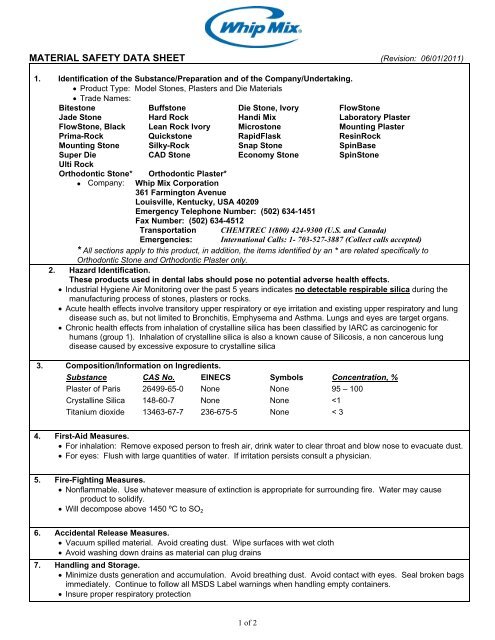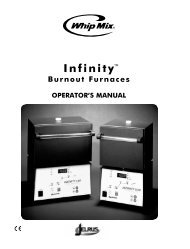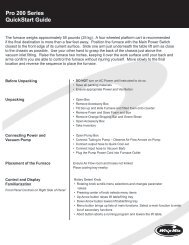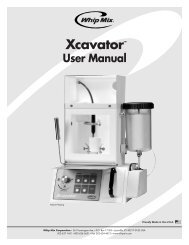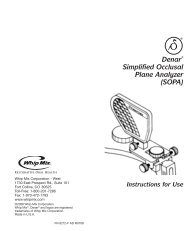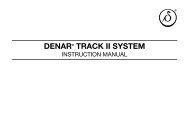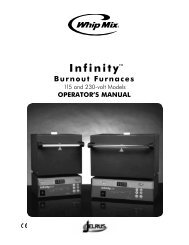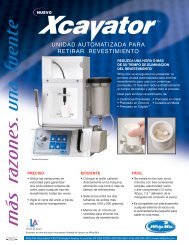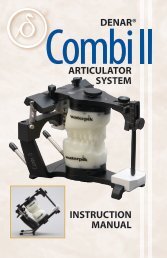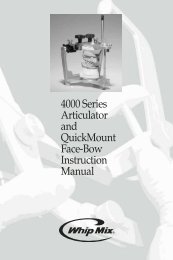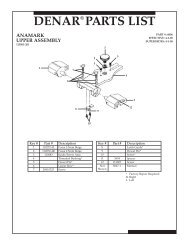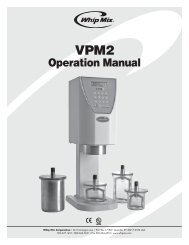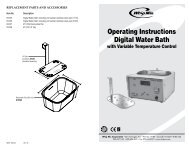Model Stone MSDS - Whip Mix
Model Stone MSDS - Whip Mix
Model Stone MSDS - Whip Mix
You also want an ePaper? Increase the reach of your titles
YUMPU automatically turns print PDFs into web optimized ePapers that Google loves.
MATERIAL SAFETY DATA SHEET (Revision: 06/01/2011)<br />
1. Identification of the Substance/Preparation and of the Company/Undertaking.<br />
• Product Type: <strong>Model</strong> <strong>Stone</strong>s, Plasters and Die Materials<br />
• Trade Names:<br />
Bitestone Buffstone Die <strong>Stone</strong>, Ivory Flow<strong>Stone</strong><br />
Jade <strong>Stone</strong> Hard Rock Handi <strong>Mix</strong> Laboratory Plaster<br />
Flow<strong>Stone</strong>, Black Lean Rock Ivory Microstone Mounting Plaster<br />
Prima-Rock Quickstone RapidFlask ResinRock<br />
Mounting <strong>Stone</strong> Silky-Rock Snap <strong>Stone</strong> SpinBase<br />
Super Die CAD <strong>Stone</strong> Economy <strong>Stone</strong> Spin<strong>Stone</strong><br />
Ulti Rock<br />
Orthodontic <strong>Stone</strong>*<br />
• Company:<br />
Orthodontic Plaster*<br />
<strong>Whip</strong> <strong>Mix</strong> Corporation<br />
361 Farmington Avenue<br />
Louisville, Kentucky, USA 40209<br />
Emergency Telephone Number: (502) 634-1451<br />
Fax Number: (502) 634-4512<br />
Transportation<br />
Emergencies:<br />
CHEMTREC 1(800) 424-9300 (U.S. and Canada)<br />
International Calls: 1- 703-527-3887 (Collect calls accepted)<br />
* All sections apply to this product, in addition, the items identified by an * are related specifically to<br />
Orthodontic <strong>Stone</strong> and Orthodontic Plaster only.<br />
2. Hazard Identification.<br />
These products used in dental labs should pose no potential adverse health effects.<br />
• Industrial Hygiene Air Monitoring over the past 5 years indicates no detectable respirable silica during the<br />
manufacturing process of stones, plasters or rocks.<br />
• Acute health effects involve transitory upper respiratory or eye irritation and existing upper respiratory and lung<br />
disease such as, but not limited to Bronchitis, Emphysema and Asthma. Lungs and eyes are target organs.<br />
• Chronic health effects from inhalation of crystalline silica has been classified by IARC as carcinogenic for<br />
humans (group 1). Inhalation of crystalline silica is also a known cause of Silicosis, a non cancerous lung<br />
disease caused by excessive exposure to crystalline silica<br />
3. Composition/Information on Ingredients.<br />
Substance CAS No. EINECS Symbols Concentration, %<br />
Plaster of Paris 26499-65-0 None None 95 – 100<br />
Crystalline Silica 148-60-7 None None
8. Exposure Controls/Personal<br />
• Exposure Limits (as respirable dust). All values are mg/m 3<br />
OSHA-PEL ACGIH-TLV, 2011<br />
Nuisance Dust (Respirable) 5 Withdrawn<br />
Crystalline Silica (Respirable) 0.1 0.025<br />
• Personal protective equipment: None required during normal laboratory use.<br />
• Engineering controls: Use local ventilation to keep employee exposure to respirable dust below 0.025 mg/m 3 .<br />
• Respirator: Use respirator approved to NIOSH/MSHA half face with HEPA cartridges for exposures up to 10<br />
times exposure limits.<br />
9. Physical and Chemical Properties.<br />
• Solid, odorless powder, with variety of colors<br />
Vapor pressure (mmHg) Not Applicable Vapor density (air = 1) Not Applicable<br />
Melting Point ºC 145º Boiling Point ºC Not Applicable<br />
pH Not Applicable Specific gravity/density 2.5 – 3.5<br />
Solubility in water 0.2% Flash point ºC Not Applicable<br />
• No dangerous reactions are known to occur with proper handling and storage.<br />
10. Stability and Reactivity.<br />
• Basically stable, may solidify and generate heat if in contact with water. Will decompose above 1450 ºC<br />
11. Toxicological Information.<br />
• Route of entry: Inhalation. Inhalation of excessive dust over a prolonged period may result in lung damage.<br />
• Effects of acute exposure: None known.<br />
• Carcinogenicity: The International Agency for Research on Cancer (IARC) reports inhaled crystalline silica is a<br />
Group 1 carcinogen to humans. NTP has listed crystalline silica as carcinogen.<br />
12. Ecological Data.<br />
• No ecotoxicological studies are available. Generally considered chemically inert in the environment. Not<br />
dangerous to water life.<br />
13. Disposal Considerations.<br />
• Waste is not hazardous as defined by RCRA (40CFR 261). Avoid washing down drains as material can plug<br />
drain.<br />
14. Transport Information.<br />
• No special transport requirements, non-dangerous goods<br />
• ICAO/IATA-DGR: Not applicable<br />
15. Regulatory Information.<br />
• SARA III information: For purposes of SARA III reporting, these products contain no ingredients on the<br />
extremely hazardous CERCLA, or section 313 lists.<br />
• SARA Extremely Hazardous Substances 40 CFR 370: Acute<br />
• CERCLA: This product is not listed with CERCLA (40 CFR 117,302)<br />
• OSHA Hazardous Communication Standard (29 CFR 1910.1200: Contains material considered hazardous.<br />
• ICAO/IATA-DGR: Not applicable<br />
16. Other Information.<br />
• HMIS Rating: Health 1 Flammability 0 Reactivity 0 Other 0<br />
Hazard: 4-Severe; 3-Serious; 2-Moderate; 1-Slight; 0-Minimum<br />
Prepared By: Donna Ringo, CIH<br />
Date: 6/13/2011<br />
CPL90533 I:\msds\modelsto.nes(rev. 06/01/2011)<br />
Translated By:<br />
Date:<br />
2 of 2


